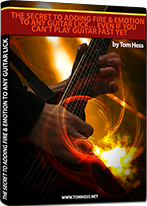The Ultimate One Note Guitar Solo Lead Guitar Playing Guide
by Tom Hess
Emotion To Any Guitar Lick

EMAIL TO GET ACCESS
By submitting your info, you agree to send it to Tom Hess Music Corporation who will process and use it according to their privacy policy.
You are about to learn how to say more with 1 lead guitar note...
...than most people can say with a thousand notes in their guitar solos.
I'm going to show you a few secret guitar phrasing tips most lead guitar players don’t know about playing emotional guitar licks.
Then...
I’ll lay out the lead guitar skills you need to practice to make your guitar phrasing super dramatic and emotional.
Best part?
None of the guitar phrasing concepts you are about to learn are hard to understand or do.
Simply do what I teach you when you practice lead guitar...
...and soon you’ll be blowing everyone away with the emotion of your guitar solos.
Emotion To Any Guitar Lick

EMAIL TO GET ACCESS
By submitting your info, you agree to send it to Tom Hess Music Corporation who will process and use it according to their privacy policy.
Sound good?
Let's begin.
Check out the lead guitar video tutorial that shows you what to do:
Now that you’ve seen how to play emotional guitar licks with just one note…
Let’s go deeper into the individual guitar phrasing techniques that help you play guitar solos with feeling.
Practice these guitar phrasing techniques that will help you play emotional guitar licks and guitar solos:
Lead Guitar Soloing Tip #1: Learn Other Scales Besides Pentatonic Scales
This may come as a shocker, but:
…pentatonic scales (the standard ones) are NOT the best scales to use when you want to play lead guitar with feeling or create emotional guitar licks.
That’s because all the drama and tension you create with your lead guitar playing is in the half steps between notes in the scale.
And guess what?
The typical pentatonic scale has no half steps. This means: even in blues guitar solos, guitar phrasing often lacks emotion due to lack of half steps in the scale.
What other lead guitar scales should you use?
Answer: practice playing guitar solos using 7-note major and minor scales.
There are many other lead guitar scales you can use as well…
… but if you are new to playing guitar solos, learn standard major and natural minor scales first.
Note:
When you learn a new scale, practice creating emotional guitar licks with it using the entire fretboard. Don’t just play the scale in one position and play guitar solos in one spot of the guitar.
This makes your lead guitar playing sound boring.
Even great guitar phrasing can’t make up for playing the same notes in all your guitar solos.
Watch this video to see how to practice playing scales all over the guitar neck during your lead guitar practice:
Question: “Tom Hess, what other lead guitar scales can I learn besides major and minor to create emotional guitar licks and guitar solos?”
Answer: Focus on major and minor scales first. After you learn them all over the guitar, focus on your guitar phrasing. You can spend many months creating emotional guitar licks and awesome guitar solos with just the major (or natural minor) scale.
When you learn more about music and your general lead guitar chops improve, you’ll be ready to learn more scales, like the Mixolydian b6 mode for example.
Lead Guitar Soloing Tip #2: Improve Your Lead Guitar Sustain
Sustain is one of the keys to emotional guitar licks. If you want to master guitar phrasing – you must have great sustain.
And contrary to popular belief, you can achieve great sustain in your lead guitar playing and guitar solos, without shelling out cash for a sustainer, active pick ups, pedals, new amps or even new strings.
Here is all you need:
- Your 2 hands,
- A stiff guitar pick (that doesn't flex when you hit the string)
- And an amp with its gain turned up all the way to 10.
(Oh, and you’d better have your guitar volume and “tone” knobs turned up to 10 too…
...but that goes without saying.)
Watch this video to see how to build great sustain:
Note: another key piece of lead guitar sustain is…
… controlling sloppy string noise.
If you let sloppy string noise into your playing, it doesn't matter how good your guitar phrasing is or how good you are at creating emotional guitar licks…
…Your guitar solos will sound like crap!
Here is how to fix it:
1. Use thumb muting to mute the lower (in pitch) guitar strings as you play guitar solos.
Rest your thumb on the lower strings and slide it up and down as you play.
This is especially important when you do string bends and vibrato (or vibrato on bent notes) during your most emotional guitar licks.
Common Lead Guitar Question: “Tom Hess, I try to do thumb muting, but all I hear are pinch harmonics! How can I fix this part of my guitar phrasing and make my guitar solos sound clean?”
Answer: If you hear pinch harmonics, it means you are holding the guitar pick wrong.
Most people hold the guitar pick on the side of their index finger (and let the thumb hang over the edge of the pick).
This makes thumb muting impossible and many lead guitar phrasing techniques become hard to play.
The result: you become less free to express emotion in your music.
The solution?
Change the way you hold the guitar pick. Slide your thumb back so it does not hang over the edge of the pick.
And hold your pick between the fingerprint of the index finger and thumb. (Same way you’d hold it when picking up a pen.)
This lets you do thumb muting easily and makes it easy to fill your guitar solos with emotional guitar licks.
And with this control over your guitar phrasing comes greater sustain and greater ability to express emotion in your lead guitar playing.
2. Use the index finger of your fretting hand to rest on the higher in pitch strings.
This is especially important when you play bent notes on the thicker (in pitch) strings and the thinner strings are free to ring out.
Same goes for pinch harmonics (that add fire to your guitar phrasing and help you play emotional guitar licks with great guitar phrasing).
Speaking of pinch harmonics…
… here is a lead guitar video that helps you play pinch harmonics consistently and accurately:
Question: “But Tom Hess, aren’t pinch harmonics just for rhythm guitar playing? Do they apply to lead guitar playing as well?”
Answer: Pinch harmonics are not just for rhythm guitar. They sound great in lead guitar playing as well. Use them to play emotional guitar licks and enhance the guitar phrasing of your guitar solos.
But back to string muting during your lead guitar playing:
Another great way to mute string noise is to use the fingers of your picking hand that aren’t holding the pick.
This helps to mute the lead guitar notes higher in pitch than the one you are playing. And it ensures your guitar phrasing (and sustain) sounds great.
Lead Guitar Soloing Tip #3: Refine Your String Bending And Vibrato Technique
String bends and vibrato are key elements of your guitar phrasing that make or break your guitar solos.
Here are the key technique points to know about practicing string bends for lead guitar and creating emotional guitar licks with them:
- Wrap your fretting hand thumb around the neck of the guitar. Press the web between your thumb and index finger against the back of the guitar neck and then bend the guitar string.
- Bend guitar strings by rotating your forearm. Do NOT do guitar string bends with your fingers. If you do – it’s very hard to play emotional guitar licks, because your string bends sound out of tune. (This makes your lead guitar playing sound totally awful!)
- The correct motion for guitar string bends should look and feel just like you are turning a doorknob. Get this part right and you'll have beautiful sounding guitar string bends when you play lead guitar.
Note: this doorknob motion isn’t just important for guitar string bends – it’s also key to a great sounding vibrato in your lead guitar playing.
Watch this video to see it in action:
What if you are doing your best to play string bends in tune as you work on your guitar phrasing during your emotional guitar licks, but your lead guitar string bends still sound out of tune?
Don’t worry - here is a simple way to fix it:
Play a note you plan to bend up to as a regular unbent pitch. Then bend into that note by bending the guitar string from a lower pitch.
For example: say you are bending a string from fret 5 up to 7. Play the 7th fret first (as an unbent note). This is called the target note of your guitar string bend.
Now, bend the string from fret 5. Stop when you hear the string bend is in tune.
Bonus tip: There is a name for this technique. It's called a re-articulation guitar string bend (where you play a note and then bend the guitar string right into that same note).
Use these re-articulation string bends in more of your emotional guitar licks. They sound great!
Question: "Tom Hess, what if I have still have trouble doing guitar string bends in tune even after all the above advice?"
Answer: Do this: tune your guitar down by ½ step, or a whole step (or even more if you want). When you do this, your string bends will suddenly feel way easier to do.
Try it and it won't be long before you start nailing string bends and playing emotional guitar licks.
Then you can tune your guitar back up to standard tuning and enjoy the improved sound of your lead guitar playing :)
Lead Guitar Soloing Tip #4: Model Your Guitar Phrasing After Great Singers. Here Is How:
The best examples to model for your guitar phrasing and emotional guitar licks are… not guitar players.
They are singers.

Here is the best guitar phrasing exercise you can ever do that can help you create emotional guitar licks and great guitar solos:
1. Make a list of your favorite singers in any style. (Although I suggest staying away from opera.)
2. Listen to the tunes you selected and pay attention to just the vocal parts. Notice how well singers use vibrato and think about how you can copy this in your emotional guitar licks and lead guitar solos.
And compare this with how lead guitar players typically play when they try to play lead guitar solos (or when they try to play emotional guitar licks).
Also notice how few notes singers sing per phrase. (And compare this to your average lead guitar player and how many notes the average player crams into his guitar phrasing.)
3. Transcribe the singer’s vocal parts on your guitar. Note: do your very best to match the singer’s phrasing with your guitar phrasing.
The more of the vocal nuances you can match with your guitar phrasing, the easier it becomes to create emotional guitar licks and play lead guitar solos that drip with feeling.
Do this kind of practicing every week and your guitar phrasing will grow tremendously.
Here is an example of how to model your guitar phrasing after a singer’s vocal style:
Lead Guitar Soloing Tip #5: Use Lead Guitar Syncopation In Your Guitar Phrasing Ideas - Here Is How:
Syncopation is a really simple way to add drama & tension to any guitar lick.
It takes almost no practice, works in any style, and...
…it’s one of those techniques that’s almost impossible to screw up.
Here is how to use syncopation to create emotional guitar licks:
You heard me use syncopation in the very first lead guitar video (at the top of this page).
Yes, you can do syncopation on just 1 note.
Syncopation helps you milk your guitar phrasing ideas for much longer and squeeze more fire from every note.
Now that you know how to make your guitar phrasing sound better, let me ask you a question:
Doesn't it drive you crazy when your guitar playing sounds good on one day, but sounds bad the next day?
It’s really frustrating when you can’t rely on your skills to be at your best all the time. It gets worse when other people are watching you play or you want to record your playing.
I want to help you solve this problem once and for all. There is a simple way to practice guitar that helps you play everything you know perfectly, consistently and reliably, like a freaking machine.
And I put together a new guitar playing eGuide that shows you how to do just that.
Download it today and start having a lot more fun playing music instead of feeling nervous about sometimes sucking when you play guitar.
 About Tom Hess: Tom Hess is a guitar teacher, music career mentor and guitar teacher trainer. He teaches rock guitar lessons online to students from all over the world and conducts instructional live guitar training events attended by musicians from over 50 countries.
About Tom Hess: Tom Hess is a guitar teacher, music career mentor and guitar teacher trainer. He teaches rock guitar lessons online to students from all over the world and conducts instructional live guitar training events attended by musicians from over 50 countries.
 | Forward this article to your friends |

